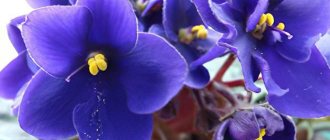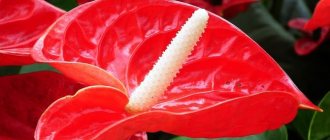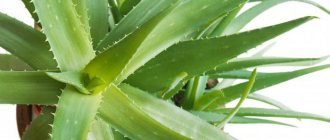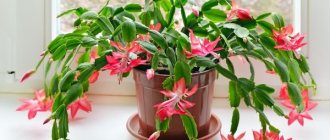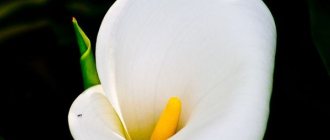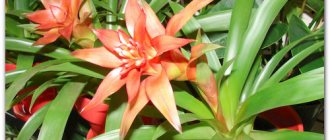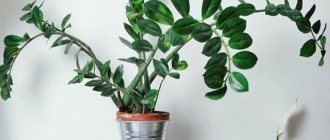Flower of happiness or widow's tears? Signs and superstitions associated with fuchsia
Fuchsia is a beautiful exotic flower from the cypress family. The plant originates from South America, from where it was introduced to Europe in the 18th century. Gardeners love fuchsia for its elegance, stunning blooms from April to mid-autumn, and variety of species and colors.
There is a beautiful legend about the appearance of fuchsia; many superstitions and beliefs are associated with this flower. People call it the flower that brings good luck.
Contents Folk beliefs and observations Why does it bloom? Why is he dreaming? Can I keep the plant at home? What are the benefits of home flowers? What could be dangerous? The meaning of a flower according to Feng Shui Where to put it?
Popular varieties of fuchsia
An unusually popular and beautifully flowering ornamental crop in our country was bred by the French botanist Charles Plumière, but at present, domestic amateur flower growers are also aware of numerous modern varieties of both garden and indoor fuchsia. At home, only the most undemanding and highly decorative varieties of hybrid fuchsia, with abundant and longest flowering, have become particularly popular.
| Variety name | Plant characteristics | Description of flowering |
| "Alfred de Groot" | Upright, well-leafed plant | Simple flowers with pale pink sepals and a mauve “skirt” |
| "Annabel" | The variety can be grown both in bush and in hanging form | Large, double-type flowers have pinkish-white sepals and a white “skirt.” |
| "Armbro Campbell" | Blooms in winter with large double flowers with pale pink petals. | |
| "Ballerina" | Erect, leafy, highly decorative aerial part | The flowers have bright scarlet sepals and a lush whitish-pink “skirt” |
| "Imperial Crown" | Elongated scarlet flowers collected in relatively large brushes | |
| "Cecile" | An upright and fairly densely branched plant | Densely double flowers with red sepals and a bluish-lilac, wavy “skirt” |
| "Marinka" | A highly decorative ampel-type plant with abundant flowering | Numerous, simple, reddish-crimson flowers |
| "Niedersachsen" | Ampelous type large-flowered variety. | Double flowers have reddish-pink sepals and a snow-white “skirt”. |
| "Prince of Peace" | Well leafy ampelous plant | Simple, medium-sized flowers with white sepals and a reddish “skirt” |
| "White angel" | An ampelous variety, with beautifully curly and gracefully hanging shoots | Beautiful contrasting lilac-violet bloom framed by snow-white sepals |
| "Henriette Ernst" | Bush plant for growing in outdoor containers | Flowers with scarlet sepals and a light lilac “skirt” |
Popular beliefs and observations
Fuchsia is not only an attractive houseplant, it is a real home talisman. It is believed that the flower is able to protect its owners from damage, the evil eye and other damage, and fill them with energy to overcome any difficulties.
Why does it bloom?
The magical effect of fuchsia is especially effective during the flowering period.
Why do you dream?
A dream about fuchsia is a sign that the dreamer is protected from jealousy, bad thoughts against him, the evil eye, corruption and other negative magical influences.
If you dreamed of several flowers - to the successful progress of affairs, the embodiment of ideas and dreams.
Features of reproduction
Ornamental crops can be propagated by seed material
, but when grown from seeds, fuchsia rarely retains the characteristics inherent in the original plant, so this method of propagation is more suitable for breeders. When propagating from seeds, self-pollination of indoor fuchsia should be prevented by removing the anthers and applying pollen from the paternal crop to the stigma of the pistil, after which insulating the flower using a special cover.
After the fruit has ripened, the seeds are removed from it and dried a little, and then surface sowing is carried out on a moistened soil substrate in a mini-greenhouse. After a couple of months, the seedlings are picked
, and after another three months, the grown plants are planted in separate flower pots.
Most often, fuchsia reproduces vegetatively.
, and the most reliable option for such propagation is cuttings.
Despite the fact that indoor fuchsia reproduces quite well at any time of the year, it is best to carry out this activity in the spring, using young, not yet lignified cuttings 10-20 cm long. All foliage from the bottom of the prepared cuttings should be removed.
Rooting of cuttings is carried out in filtered water with a polyethylene cover.
If the technology is followed, the roots are formed in about a week to a week and a half, after which the rooted cuttings are planted in a nutritious soil substrate. Rooting directly in the ground is also allowed, but this method is less practical.
Is it possible to keep the plant in the house?
Fuchsia in the house is a talisman of prosperity and good luck. It charges members of the house with positive energy, joy, love of life and drives away bad moods and irritability, thereby reducing quarrels and conflicts.
The benefits of an indoor flower
The plant helps people find a common language, fills the atmosphere of the home with mutual understanding, support, and mutual respect.
Fuchsia is especially irreplaceable where a large family consisting of several generations lives under one roof. This eliminates resentment and alienation and allows everyone to feel needed and loved.
If the plant is in the house for a long time, its owners develop intuition, and in some cases, the gift of clairvoyance.
Owners of this flower recover more easily and quickly from heavy physical or mental stress and get rid of accumulated negative energy. Even a short moment spent next to fuchsia is enough. In addition, this plant makes the farm hardy and productive.
How can it be dangerous?
Fuchsia is sometimes called widow's flower. It is also called widow's tears. Some particularly superstitious people believe that this plant drives men out of the house. However, there is no explanation on what this negative opinion about the plant is based. Each gardener decides for himself whether or not to have fuchsia in the house. But most people who own flowers neglect this superstition and consider it wrong.
Scindapsus
Decorative liana, capable of reaching 5 meters in length, often decorates our homes and offices. Scindapsus is easy to care for, and its bright variegated foliage and intricately shaped flowers attract attention.
Men should not be near this plant, especially when it is in bloom. It is believed that scindapsus takes away sexual energy from men and causes impotence.
Unmarried girls are also not advised to have scindapsus at home. On a long stem, heart-shaped leaves grow singly rather than in pairs. Popular rumor says that a girl’s heart will not be able to find her soul mate. She will not find a groom and will remain lonely.
Feng Shui meaning of a flower
Feng Shui experts, depending on the shape of fuchsia leaves, attribute them either to the male Yang energy (if the leaves are pointed) or to the female Yin energy (if the leaves are round).
Therefore, choosing the right plant for your home should help adjust the energy in your home, directing the influence of the flower in the right direction.
But whatever the shape of fuchsia leaves, the flower will always help its owners avoid troubles and problems, fill them with vitality, energy and inspiration.
What does Feng Shui say?
Fuchsia is also appreciated by feng shui experts . Based on the shape of the leaves, they attribute it to Yang energy (pointed indicates the predominance of male energy) or Yin (rounded refers to female energy).
As a rule, soft female flowers are creeping, while energetic male flowers rush upward. By choosing the shape and external size of fuchsia, you can adjust the energy of the living space, which is very important when difficult events happen in the family.
Advice! A little attention, good care at home, and not only beauty will reign in your home, but also peace of emotions, harmony in all areas.
By planting a “ballerina” in your apartment, you can not only decorate your home, but also prevent problems and troubles. Become healthier, fill with energy and enhance your creativity.
Where is the best place to put it?
It is best to place a fuchsia pot on the northwest or northeast side of the apartment.
To ensure harmony, trust, mutual understanding and warm relationships reign at home, place the plant where all family members most often gather, for example, in the living room or kitchen.
To attract happiness in love, fuchsia is placed in the bedroom, but away from the bed.
Fuchsia attracts attention with its bright appearance. However, this plant is loved not only for its flowers. This has a very positive effect on the atmosphere in the house and on each family member.
Source
Dieffenbachia
Another beautiful but dangerous indoor flower that should be kept away from men is Dieffenbachia. Like scindapsus, it can lead to problems with potency. Fearing that they will lose their strength, the men run away from home.
Women should also be careful around Dieffenbachia. Its juice is poisonous; when it evaporates, it causes headaches, and when it comes into contact with the skin, it leaves burns.
This is a rather capricious plant. If not properly cared for, it quickly sheds its leaves and dries out. If difficulties do not frighten you and you still want to have Dieffenbachia in your home, do not keep it in the bedroom. The best place for this poisonous flower is a balcony or loggia.
Bright fuchsia - signs and superstitions
There is a legend about an evil sorcerer who wanted to achieve the love of seven dancing sisters at once. The beauties refused to become concubines to the sorcerer, so he cursed them and turned all the girls into a single bush.
Features of the flower
Family happiness
It is unknown who and why called the fairytale bush “widow’s tears,” but esotericists do not see in it any threat to family happiness. On the contrary, the plant successfully smoothes out any rough edges in relationships - between spouses or representatives of different generations.
Single women
What about single women? Can they keep fuchsia at home? Without a doubt! Signs assure that such a “neighbor” will enhance the charm and attractiveness of any lady.
FAQ
There are many questions related to fuchsia. They concern not only its growing conditions, but also its usefulness, magical properties, signs and superstitions.
Can it be kept in the room?
This flower strengthens the aura of our home. When moving to a new place of residence, you should take it with you to create your own microclimate. Fuchsia helps create a favorable aura and strengthens the energy of the home
and does not allow foreign energy to penetrate into it.
Is it possible to eat the fruit?
Yes, the fruits are edible
, they have a sweet, slightly tart taste. They are used to prepare filling for pies, liqueur, jam, and confitures. It is unlikely that you will be able to reap a rich harvest at home. And it’s quite possible to create a small dessert.
For example: you can make a delicious ice cream topping. To do this, take fuchsia and mulberry fruits, mash them, mix them with powdered sugar, mix and spread on ice cream.
The flowers are also suitable for consumption and used to decorate salads.
Even those who do not believe in omens know about their existence and try to learn something new. What is known about this beautiful flower? Let's consider what properties are attributed to fuchsia
:
The most common belief
The main superstition regarding this beautiful flower is that fuchsia is considered a widow's flower or widow's tears
. However, this plant is so beautiful and charming that most women do not pay attention to this baseless statement. Their windows are decorated with colorful fuchsia earrings.
Fuchsia in the house - signs
All plants in one way or another affect the physical well-being of people. Some “beauties” can be quite dangerous, so breeding them should be done with caution. Fuchsia for the home in this sense is a real find.
None of the parts of the bush are poisonous, and some cooks even add its seeds to food.
Fighter against negativity
But the main thing is still different. Signs and superstitions call the fuchsia flower an excellent fighter against negativity.
Source
Monstera
A beautiful tropical liana with large carved leaves looks very impressive, which is why many housewives love this plant. The flower is one of the most powerful muzhigon and vampire plants, capable of feeding on human vital energy.
Monstera can be kept in an office or other public place, but not at home. Staying near her for a long time causes headaches and insomnia. There is a scientific explanation for this.
The thing is that monstera juice is poisonous, and during watering the plant begins to actively evaporate it along with excess moisture. Such toxic fumes can cause migraines, irritability and general malaise.
A man, constantly feeling unwell, is ready to run anywhere from this place. Don't be surprised if one day he forever leaves the house in which he feels so bad.
Flower of happiness or widow's tears? Signs and superstitions associated with fuchsia
Fuchsia is a beautiful exotic flower of the fireweed family. The plant's homeland is South America, from where the flower was brought to Europe in the 18th century. Flower growers love fuchsia for its elegance, lush flowering from April to mid-autumn and variety of types and colors.
There is a beautiful legend about the appearance of fuchsia; many signs and superstitions are associated with the flower. People call it a flower that brings happiness.
Origin: Brief History
This plant is popularly called ballerina.
Her flowers really resemble the figure of a ballerina. There is a very beautiful legend about this flower. It says that in the distant past there lived 7 sisters. They were very beautiful and distinguished by their dancing skills. When they danced, nature froze. A magician from another state heard about them. He decided to take one of the girls as his wife and the rest as concubines. The sisters refused. Out of anger, the magician turned them into an unusually beautiful flower, reminiscent of their dance.
The question of the date of origin of the flower is very controversial. It is generally accepted that the discovery of this plant belongs to a French priest . He went on a trip to South America. There, his attention was attracted by the original flowers, called Fuchsia Triphylla Flora Coccinea. He named them in honor of Leonard Fuchs, known in Germany as a doctor of medicine and botany. 1703 is the date of birth of fuchsia. The dried samples did not reach Europe. They died in a shipwreck.
There is another version of the origin of the plant. In 1689, there were 3 plants similar to this flower in the National History Museum in London. They got their name - fuchsia magellanica. In Europe, it began to be cultivated almost 100 years later.
Popular beliefs and observations
Fuchsia is not only an attractive houseplant, it is a real home talisman . It is believed that the flower is able to protect its owners from damage, the evil eye and other harm, and fill it with energy to overcome any difficulties.
Why does it bloom?
During the flowering period, the magical effects of fuchsia are especially effective.
Why do you dream?
Dreaming of fuchsia is a sign that the dreamer is protected from envy, unkind thoughts addressed to him, the evil eye, damage and other negative magical influences.
If you dreamed of several flowers - to a successful course of affairs, the embodiment of conceived ideas and dreams into reality.
Landing rules
To grow a highly decorative indoor plant, you must follow all planting rules. The nutrient substrate for growing fuchsia should be slightly acidic.
Both ready-made soils and those made independently from three parts of leaf soil, two parts of fibrous peat substrate and one part of medium-grained sand are suitable.
It is mandatory to fill the flower pot with drainage in the form of crushed brick chips
, small pebbles or expanded clay. The growth and development of fuchsia is extremely negatively affected by overheating of the soil, so it is recommended to use ceramic flower pots or clay flowerpots and flowerpots for planting.
Is it possible to keep the plant in the house?
Fuchsia in the house is a kind of talisman of well-being and success . It charges household members with positive energy, joy, love of life, drives out bad moods and irritation, thereby reducing the number of quarrels and conflicts.
The benefits of an indoor flower
The plant helps people find a common language, fills the atmosphere in the house with mutual understanding, support, and mutual respect.
Fuchsia is especially indispensable where a large family of several generations lives under one roof. The flower eliminates resentment and alienation, allowing everyone to feel needed and loved .
If the plant is in the house for a long time, its owners develop intuition, and in some cases, the gift of clairvoyance.
The owners of the flower recover strength more easily and quickly after heavy physical or psychological stress, and release accumulated negative energy. To do this, it is enough to be near the fuchsia even for a short time. In addition, the plant gives household members endurance and performance.
How can it be dangerous?
Sometimes there is an opinion that fuchsia is a widow's flower. It is also called widow's tears. Some particularly superstitious people believe that the plant drives men out of the house . However, there is no explanation on what this negative idea of the plant is based. Each gardener will have to decide for himself whether to have fuchsia at home or not. But most flower owners do not pay attention to this superstition, considering it false.
Is it true or is it still superstition?
Any belief is an interpretation of some event that happened in ancient times. Whether to believe in omens or not is a personal matter for everyone, although in general people are skeptical about the “legends of deep antiquity.” But there are also those who are ready to blame anyone for their loneliness and other troubles, just so as not to change anything in their character and in their habits. You can believe in omens, live in accordance with all known prejudices and still remain an unhappy person, or you can just live, just grow your favorite plants and enjoy it.
Feng Shui meaning of a flower
Feng Shui experts, depending on the shape of fuchsia leaves, attribute it either to the male Yang energy (if the leaves are pointed) or to the female Yin energy (if the leaves are round).
In accordance with this, the correct selection of plants for the home will allow you to adjust the energy inside the home, directing the effect of the flower in the right direction.
But no matter what shape the leaves of fuchsia have, the flower will always help its owners avoid troubles and problems , fill them with vitality, energy and inspiration.
Diseases and pests
With proper care, strong immunity protects fuchsia from diseases and resists pests. However, there are a number of diseases that can affect your plant.
Powdery mildew is characterized by a pronounced white coating and the appearance of liquid droplets.- Gray rot makes the plant watery and soft. A plaque appears on the leaves. The cause is too humid air.
- Rust appears as brown spots, spreads very quickly and requires immediate treatment. If you keep the flower in the required microclimate, you can avoid the use of drugs and preserve the plant.
Fuchsia can also be affected by pests such as whiteflies, spider mites and aphids. To cure the plant it is necessary to use insecticides.
Where is the best place to put it?
The best choice for placing a fuchsia pot is the north-west or north-east side of the apartment.
In order for harmony, trust, mutual understanding and warm relationships to reign in the house, the plant is placed where all family members most often gather , for example, in the living room or kitchen.
To attract good luck in love, fuchsia is placed in the bedroom, but at some distance from the bed.
Fuchsia attracts attention with its bright appearance. However, it is loved not only for its flowering. The plant can have a huge positive impact on the atmosphere in the house as a whole and on each family member individually.
Source
How to grow at home and in the garden?
They grow it indoors in pots on window sills, baskets, as hanging plants and in garden plots. The flower does not tolerate frost. In the spring it is planted in a flower garden, and in the fall it is taken to a cool room. Large pots are used for replanting. The stems are trimmed.
Important! Creating the right wintering conditions is an important factor in obtaining large and strong plants for the next season.
At first glance, it seems that fuchsia is unpretentious to grow. But there are a number of secrets. Basic care tips :
- It is not recommended to move the pots to another place so as not to lose leaves and buds;
- to give its crown a beautiful shape, it is necessary to trim and pinch the top no later than April;
- in winter she does not need bright light, otherwise she may shed leaves;
- It is necessary to remove the buds that appear in winter;
- low air humidity, high room temperature, poor watering lead to leaf fall;
- It is better to plant it in light pots so that the earth does not overheat (the plant may die);
- the optimal temperature for wintering is about 10°;
- It is recommended to grow it on windows located on the eastern and western parts of the house; on southern windows it must be protected from direct sunlight;
- It is better not to use windows on the north side; on them the plant grows with small leaves and flowers and blooms poorly;
- water with settled water, do not allow it to stagnate in the pan;
- generous flowering in the new season is facilitated by reduced watering in October and minor watering from November;
- spraying is necessary;
- from April to September it needs regular feeding with fertilizers intended for flowering;
- drafts or poor watering lead to the shedding of leaves;
- new buds are better formed if faded flower stalks are removed;
Fuchsia. Ballerina flower
Flower growers' homes contain a large number of beautiful and inspiring plants.
Every housewife thinks about replenishing her greenhouse with Fuchsia, a flower belonging to the Fireweed family.
The birthplace of the perennial plant is considered to be Central and South America, as well as New Zealand.
At home they are used to decorate the room.
Dieffenbachia
One of the most beautiful plants in our hit parade is, without any doubt, Dieffenbachia. But, unfortunately for all lovers of beautiful flowers, it is poisonous. It is especially dangerous for children who would not mind playing with it. Harmful fumes also have a strong impact on people’s health, especially in poorly ventilated areas.
But that’s not why Dieffenbachia is dangerous for men. It can negatively affect a man's virility. Many representatives of the stronger sex complained about the corresponding problems after the appearance of this seemingly harmless man in the house. However, a short-term effect is unlikely to have a significant impact on human health, but a long-term effect is likely to result in sexual impotence.
What is a plant
The attractive appearance of Fuchsia will not allow either household members or guests to show indifference. The plant has numerous stems that can be flexibly positioned in any direction.
Abundantly arranged leaves cover the branches and have an unusually colored plate of pronounced green or reddish color. The leaf shape is oval-lanceolate, with a length of no more than 0.5 cm and a characteristic pointed end.
The flowers of the plant resemble a bell with elongated stamens.
Depending on the acquired species, the appearance may be simple, or it may differ in double flowers.
After a long (from April to mid-autumn) and abundant flowering, the buds leave behind edible sweet berries that can be used to make pies, liqueur, jam or decorate ice cream. The flowers themselves are also used to decorate salads.
People often call the flower “Ballerina”, due to its great resemblance to the figure of a ballerina.
Fuchsia. Home care
The gardener does not need to put a lot of effort into caring for Fuchsia.
The soil should not be excessively waterlogged or, conversely, dry. Maintaining constant humidity promises the plant a healthy appearance and long flowering. When flooding the soil, it must be drained and allowed to dry a little.
Brown-yellow spots on the leaves will help you understand that there is a lot of water in the earth. In the case of wilted leaves, but proper watering, the pet needs to take a shower or spray it, the flower really likes it.
The best time to moisten the soil, especially in summer, is considered to be early morning or evening, when there is no scorching sun.
The plant is characterized as resistant to diseases and pests.
If whiteflies appear, you should immediately wash the stems and lower parts of the leaves with warm water and laundry soap, avoiding contact with the ground and roots. A polyethylene film placed on top of the soil can serve as an excellent protection against penetration of the mixture.
Spider mites can appear in a flower when the plant is in a room with warm and dry air. In this case, the plant can only be saved by treatment with biological products.
Positive signs
Fuchsia belongs to a number of flowers that are purchased by housewives not only to decorate the house, but also to create a positive atmosphere.
This is due to the fact that the plant has been considered magical since ancient times and carries a number of signs and superstitions that endow all households with positivity and determination. But this is not the entire list of benefits of the flower.
For businessmen or people involved in activities that require developed intuition, a flower is simply irreplaceable.
Creative people must place Fuchsia at home for a surge of energy and vitality.
Harmonization of disturbed energy also applies to the ability of the plant.
When there are children in the family, Fuchsia located in the room, where household members of different ages often visit, will help to find common interests and eliminate misunderstandings between different generations.
In difficult situations, the plant will help you find a quick solution.
Think creatively and take non-standard actions that will help radiate creative energy.
For women caring for a flower, charm and charm are presented as gratitude.
A pot with a flower located in the house reduces the risk of diseases not only of the gastrointestinal tract, but also of the mammary and thyroid glands.
When purchasing a new home, the first plant that will strengthen auras and block the penetration of negative energy from the outside should be the Fuchsia flower.
A person who has this green pet always feels a surge of strength and stands out for his cheerfulness and love of life.
Negative signs
Most women who have Fuchsia on their windowsills do not attach much importance to its negative feature, associated with another belief that characterizes the plant as a widow's flower or widow's tears.
But experienced flower growers reassure the future owners of the flower that such a statement is unjustified and groundless.
Any appearance of yellow or black dots on the leaves does not carry any frightening signs. This only symbolizes improper care, watering or the development of any pests.
Loving Fuchsia and treating her like a member of the family will mark the beginning of strong friendships with all household members and the risk of a negative attitude will simply go away.
The plant cannot harm those who are gentle, friendly and attuned to the flower with an open soul.
Source
Use in cooking
In cooking, fuchsia is used to prepare delicacies. Delicious jam is made from its berries. Fuchsia fruits have a sweet, slightly tart taste. For one serving of jam you will need 1 kg of berries, 1 lemon, 800 grams of sugar, vanillin. Fuchsia fruits are cut into halves, sprinkled with sugar, poured with the juice of one lemon, flavored with vanilla and the berries are left for 12 hours. Then place the pan with the berries over medium heat and cook, stirring, until boiling. Boil the jam for several minutes, remove from heat and pour into jars.
Fuchsia berries are highly valued in cooking and are often used to decorate dishes. Black and purple berries look great against the background of cakes, biscuits, and pastries. They taste very pleasant: they resemble the taste of kiwi and grapes, only a little less sweet.
Different varieties of this plant have fruits of different shapes. When they are ripe, fuchsia becomes like a small cherry tree. The fruits are also suitable for making confitures, liqueurs, sweet sauces, and fillings for pies.
Harm of fuchsia and contraindications
The plant can cause harm to the body due to individual intolerance. For gastronomic purposes, only fuchsia berries are consumed. If the plant has been treated with pesticides, then eating its fruits is hazardous to health.
Signs and superstitions for Fuchsia in the house
In different parts of the world, people have always strived to create comfortable living conditions for themselves. Today, every apartment has televisions, washing machines, dishwashers, vacuum cleaners and other appliances. Which is ready to make life easier. In addition to practicality, people do not forget about the aesthetic side of the issue. Houseplants today, like hundreds of years ago, continue to decorate homes. Fuchsia is a beautiful perennial plant often chosen for home decor. There are many beliefs associated with them. Let's look at the signs and superstitions about the fuchsia flower.
Cypress
The last muzhegon on the list is cypress. The sign appeared in the same way as in the case of rowan. In addition, cypress, as folk superstitions say, has one of the most negative energies among all known plants. That is, its bad influence extends not only to the male sex.
The most common plants that belong to muzhegon flowers were considered. However, you need to understand that this list is quite large. You should be careful when choosing flowers and always check first to see if the plant is carrying anything bad.
Content
Fuchsia flower folk signs and superstitions
For a long time, fuchsia has received the status of a special, magical plant. According to folk signs, a representative of the Fireweed family serves as a kind of amulet and talisman. He is able to protect the house and its inhabitants from evil forces. A person who plans to harm you or cause damage will not be able to cause harm while you are under the protection of fuchsia. A representative of the Fireweed family is able to reflect negative energy and fill the surrounding people and the room with joy and happiness; the arrowroot flower has similar energy. If you place a bush in the living room or kitchen, where the whole family and guests often gather, you will be able to minimize quarrels and conflict situations in the house. Returning home, people will experience only positive emotions, be filled with positivity and be able to relax.
During the flowering period, fuchsia has the strongest energetic force. According to folk signs, if a bush is completely covered with buds, this is a good omen:
To activate the magical qualities of fuchsia and positive signs, it is necessary to provide the bush with decent care. Only in a healthy state can it help the owner and his environment.
It is enough to water the soil in a timely manner; the soil in the pot should always be kept moist. Experts recommend watering in the morning or evening. In addition, it is necessary to maintain the temperature regime in the apartment and avoid drafts.
IMPORTANT! Most of the signs associated with a representative of the Fireweed family are positive. Combined with its easy care and attractive appearance, the bush has become a leader among indoor pets.
Top 10 muzhegon flowers
In order for the home to become even more comfortable for its inhabitants, green friends are sure to be made there. But not every plant can be grown indoors. And some of their species - the so-called muzhegon flowers - can lead to female loneliness, the breakdown of marriage and even the death of the head of the family. We present to you the top 10 of these scary plants. Whether you believe these signs or not is up to you to decide.
For lovers of flowers in the house, I recommend reading useful information about violets, dollar and money trees, as well as geraniums.
Ivy
There is such a sign that the more luxuriantly the ivy grows, the faster the marriage will break up. It’s scary to think: this muzhegon plant, as the signs say, is even capable of sucking out male energy. The most dangerous varieties of ivy have dark-colored leaves.
But for the ancient Romans, ivy was considered the flower of love, and in the paintings you can even see pots with this muzhegon at the head of the family bed. Who then to believe?
Monstera
Whatever properties are attributed to this tropical plant - monstera. “Terrible vampire” or muzhegon flower has a corresponding name, which is the same root word with monster, that is, “monster”. Terrible beliefs are associated with the ability of monstera to evaporate excess moisture before rain.
As a result, this can cause headaches for the owners of the apartment, so placing a tub of monstera in the bedroom is not recommended. Lovers of these lush vines are thinking about how to neutralize its harmful properties. And a solution was invented - to get a furry pet that neutralizes harmful energy.
Cats don't care - many of them simply love to sleep in monstera pots.
Scindapsus - the plant is also known by the names: “lotus” or golden vine
Scindapsus is grown mainly in women's groups, and representatives of the stronger sex cannot tolerate it.
This plant especially irritates them during the flowering period, because flowers resemble manhood and can reduce sexual power. The golden vine has a long stem (just imagine, as much as 5 m long), and the leaves do not grow in pairs, but at a distance from each other. Perhaps this was the reason why the harmless vine was declared dangerous.
Cactus - muzhegon flower
This is one of the most popular indoor plants. And it is not surprising that many signs are associated with it, including negative ones, such as the muzhegon flower. On the one hand, it is recommended to place a pot of cactus near the monitor to neutralize harmful radiation from the computer. On the other hand, signs call these thorny plants almost monsters. They say that a man will not marry even a very beautiful girl if she breeds cacti. Maybe the sign is based on the unknown guy’s fear of being pricked with sharp needles?
Dieffenbachia
The house plant Dieffenbachia is very beautiful, but, alas, poisonous. It is especially dangerous for young children who may want to taste it. Dieffenbachia is also capable of producing fumes that lead to headaches.
But for the stronger sex, any disease can cause severe panic, after which potency decreases. So the curvaceous southern belle ends up in the trash bin. Who wants to risk their man?
Cissus - the second name of this thin vine - indoor grape
And the signs also awarded her the ability to drive away men. Perhaps the reason is again in the single structure of the leaves. Then there will be significant savings for the family budget.
Hoya
This ivy is especially scary because it can send a man straight to the cemetery. Such a bloodthirsty plant! Honestly, the forecast can come true only in one case - if your man has the imprudence to eat the leaves of a poisonous plant.
And the roots of the sign can be found in wax flowers, which are stored for a long time. They look like artificial ones, and therefore are associated with gravestones.
Chinese rose
Hibiscus (this is another name for the Chinese rose) also has a bad reputation. The muzhegon flower tends to grow to very significant sizes. But a man needs a lot of free space, so he goes into a house where there is much more of it.
And if the spouse is capable of causing a scandal over a broken Chinese rose bud, then the husband’s departure is even more likely.
Rowan
Options are possible here, depending on geographical features. For example, in Belarus they warn about the danger not of mountain ash, but rather of viburnum. In short, both of these trees are not recommended to be planted near the house, otherwise men will avoid it.
These signs come from the custom of planting rowan (viburnum) on the graves of guys who died at a young age. That’s why young people don’t perceive such bushes.

